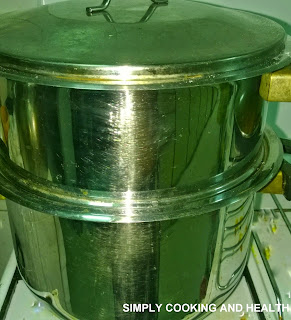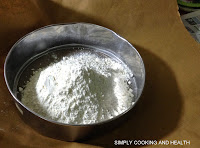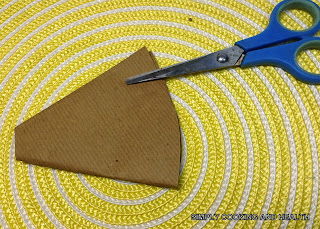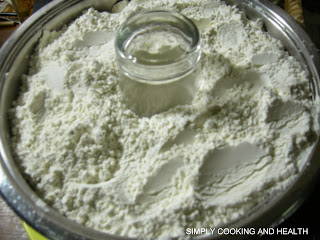 |
| steamer Steaming flour at atmospheric pressure for 15 minutes will denature the gluten and reduces the water absorbing capacity from 58.4% to 45.0%. |
Steamed flour has the following characteristics:
- mixes well with water without forming lumps
- high water uptake
- consistent flow characteristics
- no enzyme activity resulting in loss of viscosity
- no water separation while standing
- lower microbial load
Today I am going to steam the flour.
Recipe summary
For
Steaming all-purpose flour
Preparation time : 15 minutes
Cooking time : 45 minutes
1) First sift the flour. This will aerate the flour and remove any unwanted materials.
2) Then place a drinking glass in the centre of a steamer and then put the flour in the streamer around the glass.
Do not compact it but leave it as fluffy as possible so that steam will pass through it easily.
When all the flour has been added to the steamer, remove the glass before steaming and the centre hole provides space for the steam to penetrate the flour.
3) When you remove the glass hold the top part of the glass and shake it round a little and remove so that the flour does not fall in the center space.
4) When you cover and steam the flour the steam will condense on the lid or cover and fall into the flour and make a mess of it. So cover the flour with a paper with a center hole so that the condensed water will be absorbed by the paper. Today I am going to use a clean brown paper. You can use any kind of absorbent paper like news paper. If you have it is better to use a plain paper. Fold and cut the paper according to the size of your steamer.
Fold a paper into half and then make a second fold and then again a third fold. Now you can make a small cut at the top to make a centre hole. We cut in the centre to expose the opening when we remove the glass. Lastly you can make a cut at the bottom of the paper according to the size of your steamer.
5) Cover the flour in the steamer with the cut paper. Then place the lid on and steam.
6) Boil the water in the bottom pan of the steamer. When the steam begins to come out of the pan place the upper part of the steamer on the pan. (There must be some interval between the upper part of the pan and water in the bottom pan.) Let it steam for 45 minutes. In between see that there is enough water in the bottom pan. If it is not enough add hot water.
7) Then take the steamer off the heat. When you open the lid the paper will be lightly wet with the condensed water.
8) Remove the brown paper from the steamer. It will be lightly wet with the condensed water. Some water would have seeped into the flour. Scoop the wet flour with a spoon and discard. The wastage is negligible.
9) Then turn the steamer upside down to remove the steamed flour from the steamer. The flour will be slightly hard.
10) Crumble it with a roller pin while it is still hot. It will be more difficult to crumble it after cooling.
11) Sift the flour to aerate the flour. You can use this flour immediately or store in the refrigerator for later use to avoid developing mold and weevil. During the second sifting there will be some flour that will not go through. Discard it.
Another alternative is to tie the sifted flour in an old piece of cloth and steam.
When you use this method washing the cloth after use is difficult.
Steaming all-purpose flour is ready .
Recipe follows in detail with pictures.For
Steaming all-purpose flour
Preparation time : 15 minutes
Cooking time : 45 minutes
1) First sift the flour. This will aerate the flour and remove any unwanted materials.
 |
| Sifting the flour |
2) Then place a drinking glass in the centre of a steamer and then put the flour in the streamer around the glass.
 |
| Place a glass and add sifted flour |
Do not compact it but leave it as fluffy as possible so that steam will pass through it easily.
Now all the flour has
been added to the steamer
When all the flour has been added to the steamer, remove the glass before steaming and the centre hole provides space for the steam to penetrate the flour.
 |
Steamer if filled with flour
and the glass removed
|
3) When you remove the glass hold the top part of the glass and shake it round a little and remove so that the flour does not fall in the center space.
4) When you cover and steam the flour the steam will condense on the lid or cover and fall into the flour and make a mess of it. So cover the flour with a paper with a center hole so that the condensed water will be absorbed by the paper. Today I am going to use a clean brown paper. You can use any kind of absorbent paper like news paper. If you have it is better to use a plain paper. Fold and cut the paper according to the size of your steamer.
Fold a paper into half and then make a second fold and then again a third fold. Now you can make a small cut at the top to make a centre hole. We cut in the centre to expose the opening when we remove the glass. Lastly you can make a cut at the bottom of the paper according to the size of your steamer.
 |
| Make a cut at the top. |
 |
Cut in the centre to expose the
opening when we remove the glass.
|
 |
| Glass removed. The paper covers the flour but exposes the center hole |
7) Then take the steamer off the heat. When you open the lid the paper will be lightly wet with the condensed water.
 |
| After steaming. Notice the condensed water collected by the paper |
 |
| Now the paper is removed. There is some water on the top. Carefully remove the wet flour and discard |
 |
| After removing the tainted flour |
 |
| While hot break the lumps with a rolling pin |
Another alternative is to tie the sifted flour in an old piece of cloth and steam.
When you use this method washing the cloth after use is difficult.
Steaming all-purpose flour is ready .
Preparation time : 15 minutes
Cooking time : 45 minutes
1) First I will sift the flour. This will aerate the flour and remove any unwanted materials.
 |
| Sifting the flour |
 |
| Sifted all-purpose flour |
2) Then I will put a drinking glass in the centre of a steamer and then put the flour in the streamer around the glass. I will not compact it but leave it as fluffy as possible so that steam will pass through it easily.
 |
| Place a glass and add sifted flour |
3) I will then remove the glass. When you remove the hold the top part of the glass and shake it round a little and remove so that the flour does not fall in the center space.
 |
| Steamer if filled with flour and the glass removed |
 |
| Fold a paper like this to cover the flour to prevent condensing water dripping on the flour. |
 |
| Make a cut at the top. |
 |
| Glass removed. The paper covers the flour but exposes the center hole |
6) I will then boil the water in the bottom pan of the steamer. When the steam begins to come out of the pan I will put upper part of the steamer on the pan. There must be some interval between the upper part of the pan and water in the bottom pan.I will let it steam for 45 minutes. In between see that there is enough water in the bottom pan.If it is not enough add hot water.
7) Then I will take the steamer off the heat. When you open the lid the paper will be lightly wet with the condensed water.
 |
| After steaming. Notice the condensed water collected by the paper |
 |
| Now the paper is removed. There is some water on the top. Carefully remove the wet flour and discard |
 |
| After removing the tainted flour |
10) I will crumble it with a roller pin while it is still hot. It will be more difficult to crumble it after cooling.
 |
| While hot break the lumps with a rolling pin |
11)I will sift the flour again to aerate the flour. I can use this flour immediately or store in the refrigerator for later use. When we don't keep in the refrigerator it will develop mould and weevil.
 |
| During the second sifting there will be some flour that will not go through. Discard it. |
Another alternative is to put the flour and the steamer in a large wok and cover it with a larger loose lid. Then the condensed steam will fall outside the steamer top. But this will mean you will have to replenish the water in the wok a few times before the flour is fully steamed. That is why I prefer to use the lid that comes with the steamer.
Another alternative is to tie the sifted flour in a white kitchen towel or old piece of cloth and steam.
When you use this method washing the cloth after use is difficult.
I made pittu with moringa leaves from the steamed flour.

Pittu with moringa leaves


No comments:
Post a Comment